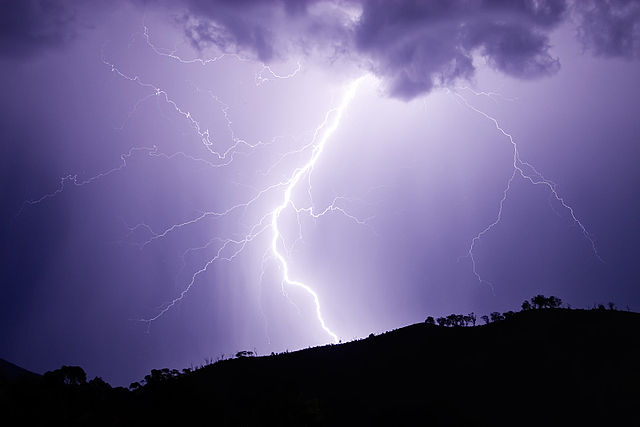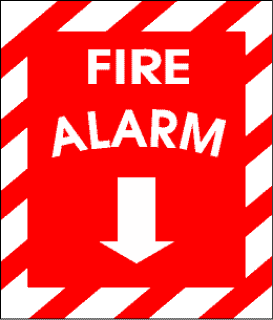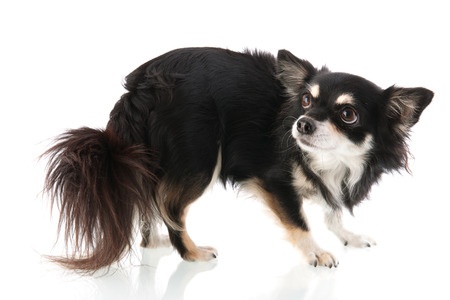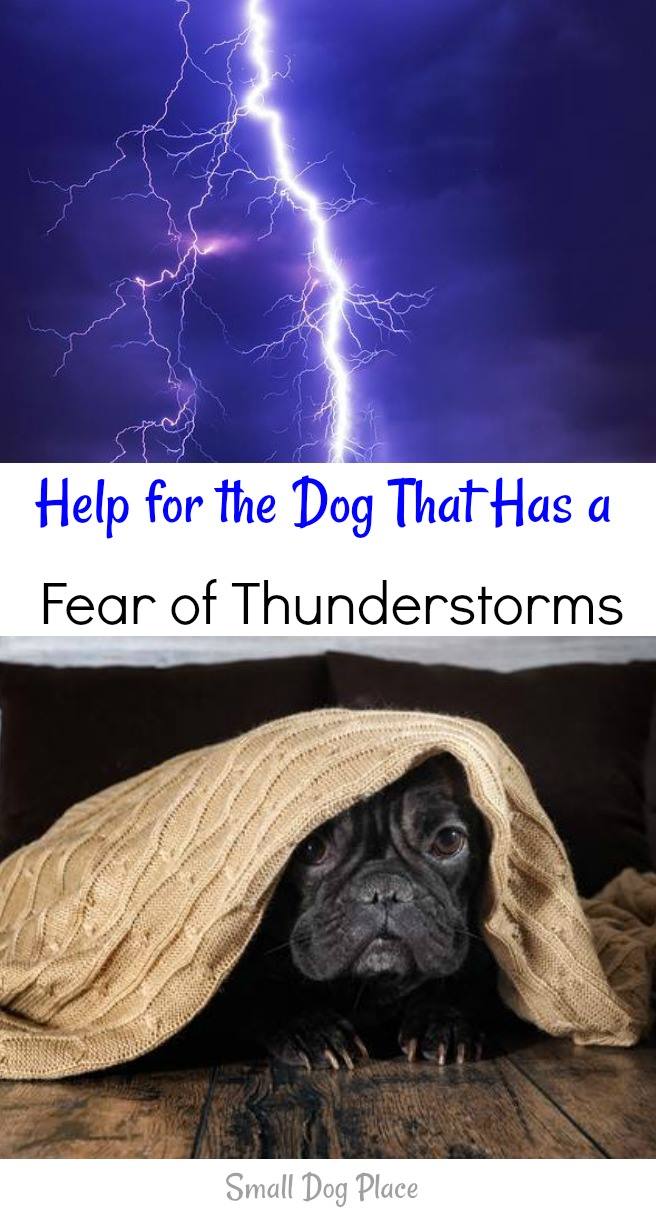- Small Dog Place Home
- Behavior Problems
- Fear of Thunderstorms
Don't Let Your Dog Fall Victim to his Fear of Thunderstorms
By Janice Jones |Last Updated 04-18-2023
Bean, my 12-year-old Shih Tzu had a fear of thunderstorms. To the casual observer, he maintains his calm, stoic demeanor, but a closer look reveals the puppy in him that is shaking and panting, heart racing, and pupils dilated.
He is visibly disturbed even before I am aware that a storm is approaching. He has a thunderstorm phobia (or storm phobia) and he is not alone.
 Fear of Thunderstorms: Helping Your Dog Overcome his Fear
Fear of Thunderstorms: Helping Your Dog Overcome his FearWhat causes a dog to have a fear of thunderstorms?
A fear becomes a phobia when it is out of proportion to the danger of actual threat. A phobia is an exaggerated or irrational fear of something that causes a reaction in an individual—physically or emotionally.
It might not be at all apparent what creates the fear in the first place. Sometimes two or more events happen simultaneous that creates a fear that has no rational understanding.
This happens in people too.
For example,

Years ago we were conducting a fire drill at a preschool I owned. One little 3 year old happened to be standing in the gymnasium near the alarm bell when it went off. After that, he was terrified to enter the gym and refused to go near the room.
He associated the loud alarm with the room that resulted in his fear. Several years later, his mom reported that he still had apprehensions when he entered anything that resembled a gymnasium.

Your dog may have had a negative experience, which triggered his fears and anxiety just like the little boy in the daycare center.
A close lightning strike, a severe storm that your dog experienced while home alone or even being caught outside when a storm struck could cause issues in some dogs.
If the owner or another dog in the household is terrified of, storms that negative energy can be passed onto the dog.
Thunderstorms may be a little different in that there is a
natural reason to have some healthy fear of them. Lightning can strike, winds can bring trees
down, and heavy rains can cause flash floods.
Unless the dog had an adverse experience associated with a storm, they
are unlikely to understand what a storm is capable of doing.
There is likely a genetic component causing phobias to storms. This is true for people and evidence for this is done through twin studies where two twins have the same phobia even though they were raised separately. In the dog world, the herding breeds are more likely to show some signs of storm phobia. In addition, dogs prone to separation anxiety also seem prone to storm phobias. Sadly, phobias only seem to get worse rather than better over time.
According to Dr. Nicholas Dodman, professor at Cummings School of Veterinary Medicine at Tufts University and founder and director of Tufts’ Animal Behavior Clinic, storm phobias are not a simple fear of loud noises.
For example, a mounting storm also involves skies darkening, rain, and wind, changes in barometric pressure and static electric fields as well as different odors produced by lightening. Dr. Dodman thinks that the dog receives a static electric shock during the storm that might be the trigger that causes the phobia. We know that static electricity fields do build up during storms. Dodson thinks some animals especially long haired breeds could become statically charged.
So, to say that your dog is afraid of
thunder may be missing some of the components of the phobia.
How do you know your dog has a fear of thunderstorms?
Dogs show a wide range of reactions when they are fearful of storms. These reactions can be physical, psychological, or physiological.
A Dog's Physical Reactions to Fear of Thunderstorms
- Shaking
- Trembling
- Looking for a Place to Hide
- Hiding under the bed or another dark place
- Following or staying close to their owner
- Wanting to be held
- Pacing
- Whining
- Barking
- Panting
- Sweaty paw pads
- Destructive behaviors including destroying property or trying to harm themselves
- Aggression
A Dog's Psychological Response to fear of thunderstorms
People talk and can tell you they are afraid. Dogs cannot, so one can only infer what is going through a dog’s head.
A Dog's Physiological Reaction to fear of thunderstorms
- Increased heart rate,
- Pupils dilated
- Salivation/Drooling
- Defecating or urinating in the house
Help Your Dog Overcome his Fear of Thunderstorms
Luckily, there are ways you can do to help your dog overcome
or at least tolerate storms, but as of this writing, there does not seem to be
a complete cure for Storm Phobias.
Here are the more common treatments that can help. All dogs respond differently, so if one method does not work, don't give up, just try another approach.
Behavioral Therapies
There are two techniques used to treat dogs with noise phobias: Desensitization and counter-conditioning. Both have also been used to treat dogs with a fear of thunderstorms.
Desensitization methods involve reducing fears over a period of several weeks. Similar to methods used in human therapies, a mild form of the feared object is paired with something positive; say a treat, petting, hugging, and attention. In this case, a recording of thunderstorm sounds is played first at a low volume and then gradually increasing the volume until the dog becomes “desensitized” to the noise.
In counterconditioning, the dog is taught (conditioned) to show
appropriate behavior in response to a specific stimulus or cue. In the
case of thunderstorms, the dog is given a special treat, a favorite toy,
engaged in a prefered behavior, only during and before a storm. The
idea behind this therapy is that the dog associates the storm with
something good.
Unfortunately, these behavioral techniques do not always work with all dogs.
Desensitization, for example assumes that the dog is reacting to the loud sound of thunder and it is those piercing claps of thunder is what is causing the phobia.
Storms are far more complex than that which we have already mentioned.
You will never be able to mimic all the effects of an actual storm to present it to the dog in gradual increments of severity.
If you want to
try it, you can purchase a CD with storm sounds directly from this page. Click on the link to the left.
Music Therapy
Calming music has been shown to reduce stress in dogs. Playing music during the storm might be helpful to reduce stress and even drown out some of the sound of thunder.
I personally love the classical selections performed by Concert Pianist, Lisa Spector, and Joshua Leeds, sound researcher, music producer, and educator.
Through a Dog’s Ear is a series of CDs that have psychoacoustically designed changes that have been clinically confirmed to relieve canine anxiety issues. The music is good for any anxious dog and has calmed my dogs (and myself) during rain or shine.
Safe Place Therapy
Encourage your dog to go to a place where she feels safe. For example, some dogs hide under the bed or in the bathtub.
A covered crate with a fluffy bed often helps a frightened dog, especially if this is the place she feels most secure. If you use a crate, leave the door open she has free access in and out.
You will want to observe her behavior and allow her access to the place she feels safe. Confining her may cause the anxiety to worsen.
Sometimes finding a place that blocks out the storm helps. A room without windows, the basement, or even a room where you can lower the blinds to block out lighting flashes will calm a stressed dog. Do not turn off the lights. Better still; turn all the lights on so it is more difficult to see any light coming through the shades from flashes of lightning.
You may also want to add some environmental sounds to block out the sound of thunder. Calming music or even the humming sound of a fan will work with some dogs.
Clothing Therapy
Tight fitting garments help some dogs who have a fear of thunderstorms, and are worth a try. Pressure garments, as they are sometimes called have the same calming effect that parents observe when they swaddle their infant.
ThunderShirt SPORT Dog Anxiety Jacket, Fuchsia, SmallThe benefits of these garments have not been proven scientifically, but there is evidence that some may work better than a placebo according to Nicole Cottam, MS, behavior service coordinator at the Tufts University Cummings School of Veterinary Medicine.

There are several products on the market that work similarly.
Play Therapy
Not in the traditional sense, but a good old fashion play session can distract your dog especially when the storm is just beginning before your dog is showing an all-out fear reaction. Play fetch or other favorite game.
Work on a little training with plenty of treats. Practice basic commands or if you have taught your dog to do a trick or two, such as "Shake" or "High Five" work on these. This would not be the best time to introduce a new command though, so keep it simple.
If your dog loves grooming, this might be a good time for a gentle brushing and massage to get her in a more relaxed state. Ttouch is a type of massage treatment and has been shown to work with dogs that are fearful, stressed, or anxious. Ttouch at www.ttouch.com
As the storm progresses, it may not be possible to ward off all the fear reaction, but it is worth a try.
Natural Remedies To Calm and Help Reduce the Fear of Thunderstorms
Pheromone Therapy: Some people have had success with using Dog Appeasing Pheromone or DAP, an artificial replicate of the pheromone produced between the mammary glands of a lactating bitch.
You can purchase it for dogs or cats and it comes in either a diffuser or spray. Or if you prefer, a collar. The diffuser is good if you work and know that a storm is approaching.
Herbal Medicines
According to Gregory Tilford from Whole Dog Journal, "valerian root, passion flower, skullcap, chamomile, and other herbs that have been widely used in animals for many years with few, if any, adverse effects."
Skullcap
According to CJ Puotinen, author of Encyclopedia of Natural Pet Care, Skullcap is a sedative, tonic herb with antispasmodic properties, which are used to control epilepsy in dogs, but for dogs with sensitivities to static electricity, it might help.
Valerian Root
This is an herb that calms and soothes the nerves, reduces tension and anxiety, restlessness and difficulty sleeping. Some have used it for their dogs heading to the show ring or a training class. You can add valerian tea to your dog's food or drinking water or add a bit of powdered root to the food.
Chamomile
Most of us know the calming effects of a warm cup of chamomile tea. Chamomile can calm nerves, relieve pain, promote deep sleep and lift the spirits. A final rinse of Chamomile tea after a shampoo smells great and reduces dander too.
Flower essences: Back’s Rescue Remedy:
Edward Back was an English Physician and homeopath. His most famous recipes work especially well in pets that are anxious or fearful and are now manufactured by different companies. Three products include Rescue Remedy Calming Essence, and Five Flower Formula. Any of these can be used to calm an anxious canine.
It is fairly inexpensive
and easy to give: just squirt a few
drops onto the dog’s tongue or gums.

Conventional Medication Therapy
If behavioral or homeopathic remedies do not work, consult your veterinarian. There are medications that can be prescribed to reduce the anxiety and calm the dog during severe storms.
Current medications that can be
used include tricyclic antidepressants (ex. Elavil), anti-anxiety medications
(ex. Xanax), sedatives, (ex. Valium) selective serotonin reuptake inhibitors,
(ex. Prozac), Beta Blocker (ex. Inderal), and tranquilizers
(acepromazine). Some drugs that
are currently being prescribed to dogs with a fear of thunderstorms include
- Alprazolam (Xanax)
- Amitriptyline (Elavil)
- Buspirone (Buspar)
- Clomipramine (Clomicalm)
- Clorazepate (Tranxene)
- Diazepam (Valium)
- Fluoxetine (Prozac)
- Inderal
- Paroxetine (Paxil)
- Acepromazine (Promace)
- Diazepam (Valium)
- Klonopin (clonazepam)
Consult your veterinarian for advice
Your Take Away
- Your dog is not bad or disobedient during a storm, he has a fear of thunderstorms, stressed and in a high state of panic. Do not take his fear of thunderstorms lightly. He is truly afraid.
- Not all of these techniques help all dogs, but with
patience, you are likely to find one that will help your small dog. Helping a dog who has a fear of thunderstorms may require more than one approach or a combination of several.
- The best thing you can do for your dog is to be calm, gentle, and patient. You are the best person to get your dog through the storm so quiet petting will help both of you weather the storm. When your dog realizes that storms mean a little extra TLC, his anxiety may be less during the next storm.
Fear of Thunderstorms: Further Reading Recommendations
Dodman, Dr. Nicholas. The Dog Who Loved Too Much: Tales, Treatments and the Psychology of DogsYour Turn...
I love to receive comments and feedback from my site’s visitors—everything helps make this site even better. Why not join in and share your thoughts about what you just read. Does your dog have a fear of thunderstorms? Have you a good treatment that you'd like to share? If you need to contact me personally, use our Contact Me form.
Have any comments, concerns, ideas or suggestions about what you just read?
Do you have any comments about this page that you'd like to share? Please take a moment and share your thoughts, ideas, comments, or suggestions for everyone to read.
About Janice (author and voice behind this site)
Having lived with dogs and cats most of her life, Janice served as a veterinary technician for ten years in Maryland and twelve years as a Shih Tzu dog breeder in Ohio.
Her education includes undergraduate degrees in Psychology with a minor in biology, Early Childhood Education, and Nursing, and a master's in Mental Health Counseling.
She is a lifelong learner, a dog lover, and passionate about the welfare of animals. Her favorite breed for over 50 years has been the Shih Tzu, but she has also lived with Poodles, Maltese, Yorkshire Terriers, Beagles, English Bulldogs, Carin Terriers, and a Cocker Spaniel.
When not writing, reading, and researching dog-related topics, she likes to spend time with her eight Shih Tzu dogs, husband, and family, as well as knitting and crocheting. She is also the voice behind Miracle Shih Tzu and Smart-Knit-Crocheting
Does This Article Deserve Your Thumbs Up?
We always appreciate your support and encouragement. Your thumbs up means so much to us. Please like this article.
If you find this page or any page on Small Dog Place Helpful, or useful in anyway, I'd love it if you would click the small heart found on the bottom right of each page.
You can also share or bookmark this page -- just click on the:

Free Monthly Newsletter
Sign Up for Our Free Newsletter and get our Free Gift to You.
my E-book, The Top 10 Mistakes People Make When Choosing a Dog (and how to avoid them)







